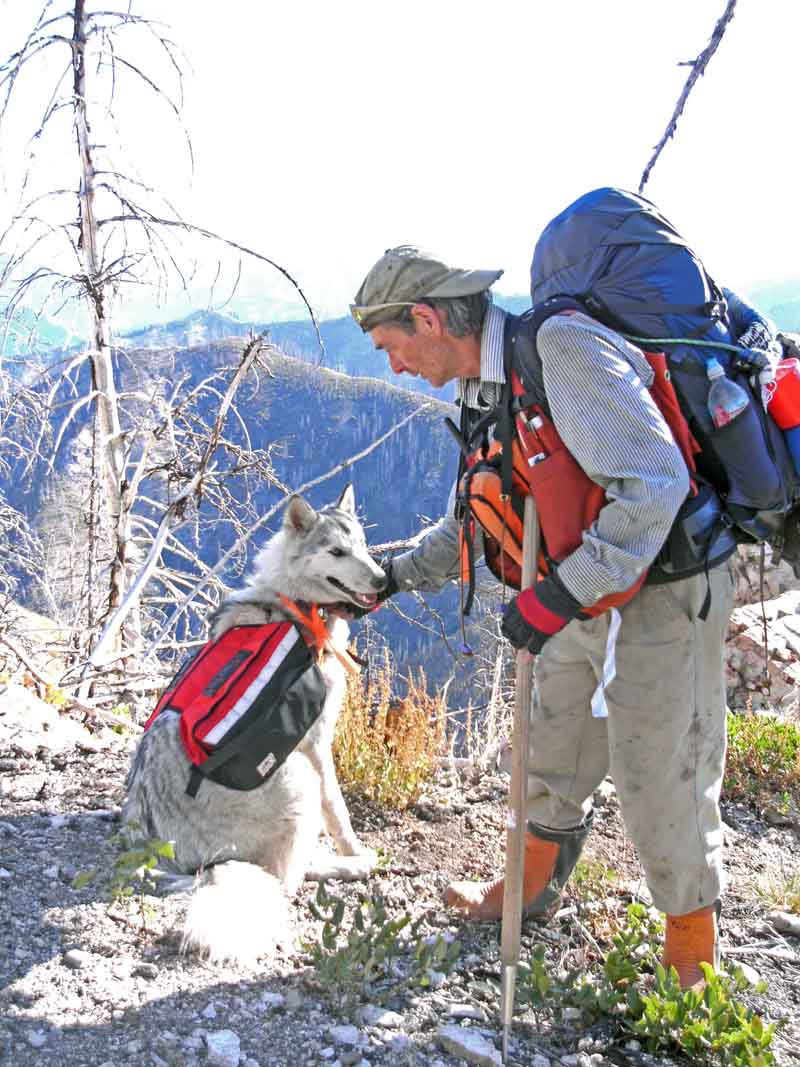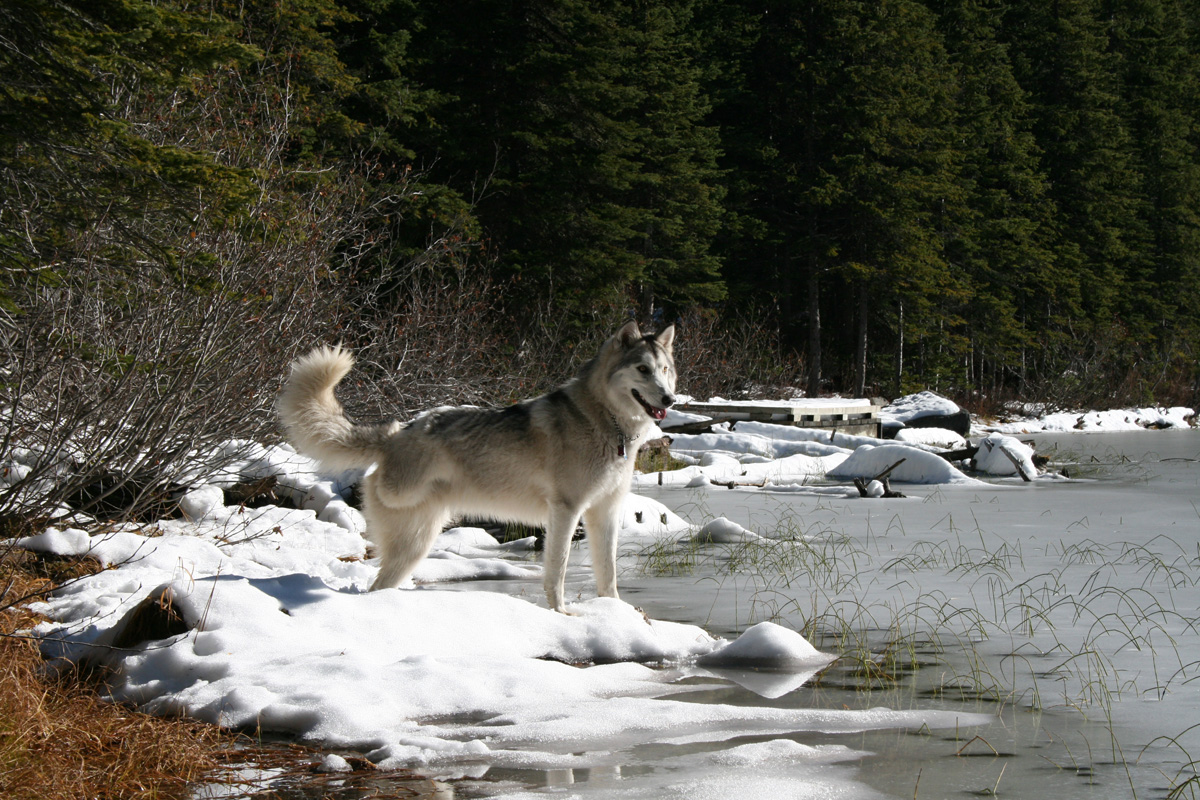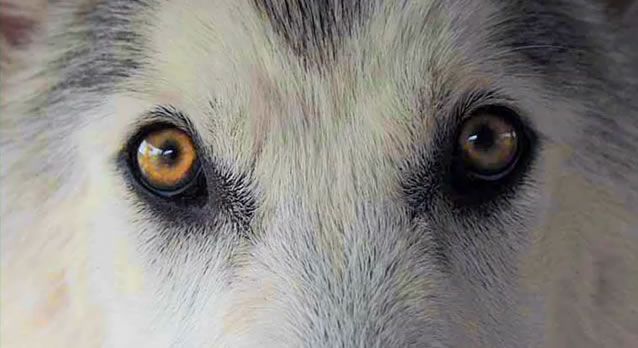Unmarked government snare almost kills Husky named Bella
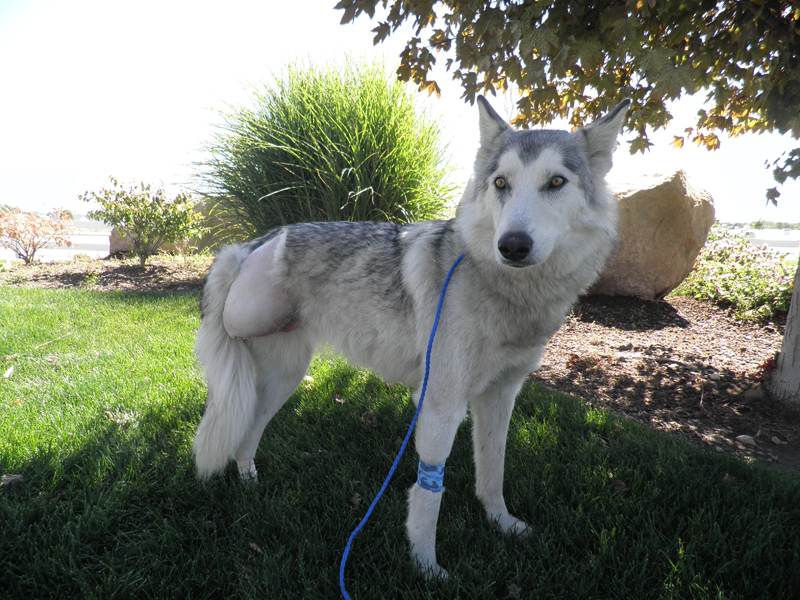
This beautiful Husky named Bella
experienced a
hellacious trauma when
caught
in an unmarked snare in Boise
National Forest. Her injuries were so
severe,
her leg had to be amputated.
Stuck for 9-10 hours with a cable choking her neck, foot and torso, Bella chewed off her own foot in a desperate attempt to free herself.
February 20, 2012 - Below you will read a suspense-filled and heart-rendering report from Robert Norie, a contractor for the U.S. Forest Service. His experience clearly details the indiscriminate hazards of predator control methods currently deployed by the U.S. goverment.
While performing a tree survey deep in the Boise National Forest of Idaho in August 2010, Norie's companion dog Bella almost died after spending an estimated 9-10 hours trapped in a Wildlife Services snare set for wolves. During his heroic ordeal rescuing Bella and hiking with her 4.5 miles back to civilization, he noted numerous violations of government directives and state law.
While both Bob and Bella survived their ordeal, it was not without huge costs. Bella lost her back leg and remained hospitalized for three weeks. Bob suffered blood poisoning from a bite Bella inflicted and had to receive hospital care for four days.
The snares and methods Wildlife Services used in this case put humans, pets and wildlife at grave risk.
Robert Norie's Account of Rescuing Bella...at Work
My name is Robert Norie. I am a forestry contractor and primarily perform contract work for the U.S. Forest Service in the state of Idaho. Often, my contracts are in remote rough, mountainous areas accessed by primitive roads, requiring a lot of hiking and spike camping to complete the work.
My contract area on the Boise National Forest near Atlanta, Idaho is about as remote as one can get. It's a 1/2-day drive from Boise, much of it on low standard and primitive roads to reach the trailhead. The actual contract area lies in a roadless area requiring a hike and spike camp 4.5 miles in.
Although I often work alone with my dog, Bella (a female 2 year old husky-wolf mix), on this particular job in August of 2010, involving natural regeneration tree surveys in the area of the 2002 Trail Creek fire, two coworkers and their dogs joined us. Our dogs camp with us and accompany us in the field during the workday. They serve as invaluable companions and also provide early alert warnings to unseen hazards, primarily bears (in 2006, on the Boise National Forest, I was briefly attacked by a sow bear, resulting in 7 stitches, when I inadvertently got too close to her cubs). We are responsible dog owners. The dogs are under voice command in the field, but are leashed if the situation warrants (i.e., approaching a domestic sheep herd). Because Bella resembles a wolf from a distance, she always wears a bright orange "DOG" vest, as well as a large red collar with a bell that can be heard from 200 feet away. Suffice it to say when you spend so much time alone with just you and your dog, the bond is strong; the dog is family and their wellbeing is as important as any human family member.
I set up base camp 75 feet from the Trail Creek trailhead. My coworkers, Eric and Adam, and I observed no warning sign of any kind or notice on the road at the Trail Creek trailhead, which leads to the Corbus Creek Trail.
Tuesday, August 17, 2010
On Tuesday morning of August 17, we prepared to hike in to a block of work in the area of the Corbus Creek/Yuba River trail where the East Fork of the Yuba River meets the trail. We had planned to spike out in the area for 3-4 nights, and Forest Service personnel were aware of our plans to work in the area for several days. We prepared our 50-pound backpacks and equipment for the 4.5-mile hike up the Trail Creek and Corbus Creek trails. The dogs had to pack their own food in.
I observed one set of about 2 day old large paw tracks on the dusty trail with no indication of recent human activity on the trail. We appeared to have the whole area to ourselves. We hiked 5 miles and set up our spike camp right next to the trail at the East Fork Yuba River. Our camp was easily visible from the trail.
About 4:30-5:00 that afternoon, a motorcycle came up the trail but was too far away to make contact. My coworkers too saw the motorcycle and said it appeared to be a man about 40 years old wearing a baseball cap. We just assumed that it was a casual rider going by since the Corbus Creek trail is a popular motorcycle trail. We thought nothing more of it until later. We had already placed several 2’-3’ strips of blue and white striped flagging along the trail with stand numbers and that day’s date indicating our starting points (RP’s-reference points as they are known). These are very noticeable as there are 3 of these strips hung together as required by the contract right on trail. That rider would have seen them and would have been alerted to the fact that there were workers in the area.
Wednesday, August 18, 2010
On Wednesday, August 18, I was first up at 5:30 am and Bella and I headed out of camp by for a long day of work. I saw no one that day until my return to camp late that afternoon when I met up with my coworkers.
They left camp shortly before noon and within ¼ of a mile from camp they encountered a person on a motorcycle described to me later as a male about 40 years old in civilian dress. The man identified himself as someone working with a USDA ‘Wildlife Agency’ but did not give out his name. This person also confirmed that he had been the motorcycle rider who passed through our area the day before August 17, 2010. This means that he had to have seen our newly hung blue and white striped flagging at various points along the trail many strips of which had that very day's date on them.
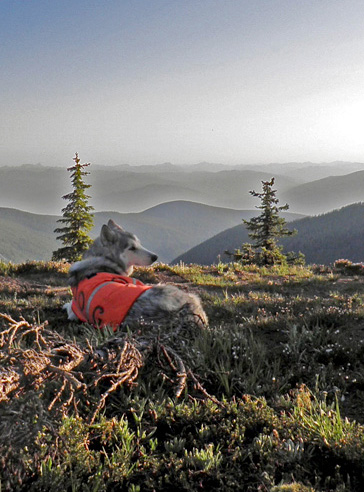
Bella a few weeks before the accident,
working with Bob at
7,300 feet in the
Selkirk Mountains,
August 8,2011.
He was monitoring and checking on reports of domestic animal predation by wolves. He said that he had set traps- both snares and foot- to ascertain if his assumption of a wolf den and rendezvous area in East Fork Yuba River was correct. He stated that the trail was closed by him under the authority of Idaho City Ranger District. My coworkers shared a chuckle with him over the ineptitude of federal agencies to have sent us into an area and allowed him to close it at the same time. He said that the snares were no threat and to simply slide them off our pet’s heads if they got caught. He said that the foot traps could cause some damage, but that it would not cause permanent harm to our dogs. He gave the precise location of a foot trap set in an area they had already crossed through, and said there were others in Yuba River. When asked for the precise locations of the traps, he reiterated that we had no need to be concerned because the traps were far removed from our project area. He was informed of our plans to be in the area, the precise location of our campsite and that I had a wolf hybrid dog. He appeared to acknowledge and understand the scope and location of our involvement in his trapping area.
The most important item here is what the trapper failed to mention, the snare trap located only 1,000 feet from our camp. A distance of 1,000 feet is only a 1-2 minute romp for a dog like Bella.
On the evening of August 18, Adam, Eric and I discussed the encounter and information provided by the trapper. We had some concerns over the traps, but Adam and Eric had been assured that his trap sites were too far away (2+ miles away) to be of concern. Also, the trapper had downplayed the effects of entrapment in the unlikely event one of our dogs should wander into a trap. Based on this information, we concluded there was no risk and decided to stay for our remaining two-three days and complete our contract work in this area.
I went to bed at 9:30 pm with Bella curled up beside me.
Thursday, August 19, 2010
On Thursday, August 19, I awoke about 5:30 am and looked around for Bella. It was just light enough to see that she was not there. I got up and noticed that her food bowl was empty. I got the fire going, had breakfast and worked on maps. Soon Adam and Eric and their dogs were up having breakfast. About 9:00 am I was about ready to start my day's fieldwork. No Bella. I decided to walk down the trail the way we came in.
I walked down the trail through a small clearing. Looking ahead I saw Bella lying in the middle of the trail. I called out her name and saw her try to raise her head. Upon approaching her I could see that she was wrapped up in a wire cable of sorts (the same size cable as that used on bicycle brakes). Blood was everywhere. She had large patches of blood on her haunches, chest and belly and a large blood clot beside her. The snare was around her neck. The cable was anchored to an 8-inch diameter log, then wrapped 7 times around (counted when we removed it) a 5-foot tall tree sapling, and finally the cable was then wrapped around her torso and her right rear leg. This is when I saw that she had no foot. It was almost surreal- no foot on the leg, just bone and tendon and dirt and twigs.
(Reader: At this point I was in a near state of shock seeing Bella like this. As I relate the following rescue events in a factual manner, please understand the severe trauma Adam, Eric, but especially Bella & I, were experiencing.)
I ran back to camp. Eric came back with me to Bella while Adam stayed in camp to keep the other dogs away to avoid confusion.
Back with Bella I knelt down beside her talking to her and reached out to see exactly where the snare was wrapped around her neck and how tight it was. This is when she bit me on my right thumb just above the knuckle. She didn’t just bite but held my thumb in a tight grip in her mouth. I had to open her jaws before she released my thumb. I believe she was just so out of it by now that she wasn’t even aware it was me. Her bite left two small incisions on my thumb, one mark larger than the other. Blood immediately covered my thumbnail and began dripping. I just wiped it off on my pants leg a couple of times, it eventually stopped bleeding and I forgot about it.
She may have been in this situation for up to 9-10 hours already, it was hard to say. Much of the blood on her body and the pieces of her foot which she had chewed off bit by bit - toes, pads, bone, and hair - were already drying out. It was very apparent that this had not just happened in the last 2-4 hours.
Our total focus was on Bella and how to go about freeing her from this snare cable. We went back to camp and retrieved a well-stocked first aid kit, a Leatherman tool, couple of rags, nylon rope, one of my camp socks, and a liter bottle of water with bowl.
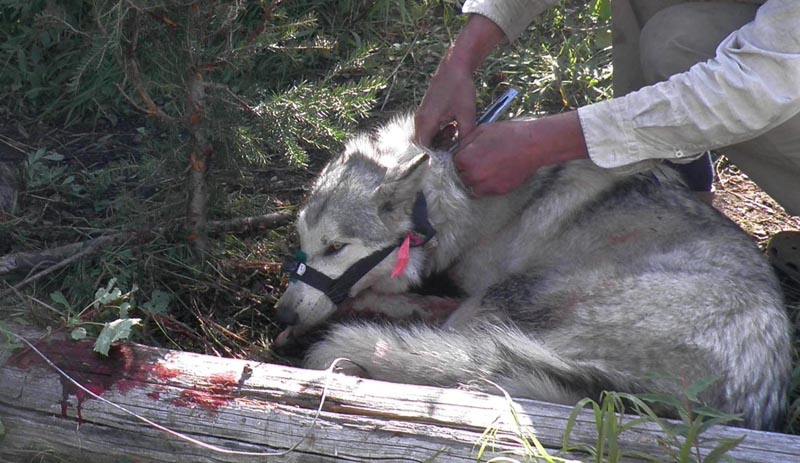
The snare was wound so tightly around
Bella's neck it was choking her.
It took
several men and much time to free her.
We decided that first we would have to muzzle her so we put a slip strap around her muzzle and then tied it to her collar. This arrangement can be seen in the pictures. After we put the muzzle on, Bella seemed more relaxed. She never resisted any of our attempts to help her after this point and we could maneuver her as needed to untangle the snare cable.
The wire cable had also become entangled in her vest. The snare portion was tight around her neck nearly choking her, and just as tight around her torso and even tighter around her leg. The cable was practically embedded in her skin, tight enough to cause wounds forming scabs in a ring around her neck documented in a picture taken by employees of the Intermountain Vet Hospital. The cable cinched so tightly around her leg may have saved her life by acting as a tourniquet.
Eric and I decided we needed Adam to assist us. Back at camp I asked Adam if he had a gun. He said he had brought his .40 Glock. I told him he did not need to bring it, although in my mind I knew if worse came to worse this would be the final alternative.
First we removed the end of the cable from the anchor log about 2 ft. from the trail. Then we unwrapped the cable from around the 5 ft. sapling (7 times). This began to give us enough slack in the wire cable so that we could move Bella’s body around so we could work on the cable still wrapped tightly around her 70 lb. frame. Eric started scissoring the cable around her neck with the Leatherman tool and after several attempts ‘cut’ through the cable. We then carefully started unwrapping the cable from around her not exactly sure where it was going to lead us. Finally we were down to just unwrapping it from around the injured leg and I just hoped it wouldn’t start bleeding again. It didn’t, which led me to believe that it indeed had been a while since this had happened.
Bella was cooperative throughout. Perhaps it was because of complete exhaustion from a night of hellacious trauma that she was so easy to work with.
Once the cable was completely free and her doggie vest cut off, we examined her entire body for any other visible wounds. None were immediately found (although two days later I could feel where the cable had actually cut into the skin around her throat for several inches). As I mentioned earlier, there was a ring of scabs around her throat from the tightened cable as documented by the staff at Intermountain Vet Hospital.
Next we started treating her injured leg, which I gently lifted up, Bella not resisting, and then rinsed off with water washing away blood, dirt, twigs, and debris. We wrapped a 4”x6” gauze pad around the end of the stub and taped it around the leg. Then a 12”x12” clean washcloth was wrapped around and taped in the same manner. Next I put one of my camp socks over the entire end of the leg and taped that very securely. Next we cut the top off a 2-liter water bottle and cut two 3” slits down each side. We put the plastic bottle on the end of the leg leaving about 2” between the bottom of the water bottle and the end of the stump. We very securely duct taped the bottle around the leg and up past the joint of the rear leg so that it would not slip down. At this point we had done all we could.
It was now time to see if Bella could get up. I used a nylon rope for a leash, tied it onto her collar and with great hope said ‘OK Bella, come on girl, let’s go!’. Bella nearly jumped up as if she had been waiting for the words ‘to go’. While I quickly packed up for the hike out, she sat waiting and appeared to be alert. We made sure the 2 way radios were all charged and I said I would call them when I hit the saddle since reception would die out once we dropped down on the opposite side.
Bella and I took off down the Corbus trail, Adam and Eric watching to see if this was going to work. It did. I never had to pull on her leash the entire 4.5 miles back to base camp.
We crossed three creeks with running water before hitting the saddle. At the first one we stopped and she must have drunk nearly a half-gallon of water-she was very dehydrated despite having given her water earlier. I let her rest a few minutes then we set off again. We stopped briefly at the next two creeks and then again about 400 ft. before the saddle where she just decided to stop and lay in the shade. It seemed like a good place to call the guys. They came in loud and clear and seemed a bit surprised that we were already near the top of the saddle. They reminded me of the trail snare and the foot trap the trapper said he had placed at the saddle.
I had already forgotten about the snare and trap. We had gone only about 100 ft when I nearly walked into the snare. The fact that I was 4’-6’ from the snare before I saw it means that if a person on a motorcycle had come through, as I had planned to come back in on the next day, the rider would never have a chance to see it if wearing a helmet and goggles. This would certainly cause a serious accident resulting in injuries or even death to the rider. This is in clear violation of Wildlife Services Directive 2.450 and of Stipulation 1 and 11 of the Wildlife Damage Management Plan Between APHIS-Wildlife Services and Boise National Forest 2010 concerning the posting of warning signs on roads and trails where traps and snares are set. Stipulation 11 also states that ‘WS may set foothold traps or foot snares on or near Forest Service roads that have been specifically closed by BNF personnel’. THERE WAS NO OFFICIAL TRAIL CLOSURE IN EFFECT AT THAT TIME. It seems to me absurd, if not negligent, that someone would set a trap on such a well-used trail without putting up warning signs to protect people who may ALREADY be in the area recreating or working, such as ourselves, from these hazardous activities.
There was a 16” diameter cable loop hung vertically about 2’-3’ above the center of the trail by a 3’-4’, ¼” steel/aluminum pole imbedded in the ground next to the trail. The end of the cable was secured to a downed log about 3’-4’ off and on the down side of the trail.
My frustration with this entire situation began to come forth. I dismantled the snare, pulled the post out of the ground unsecured it from the log and gathered the whole gob of wire cable and threw it downhill. It got hung up about 10’ above the ground in a downed burned snag. It wasn’t going to cause harm to anything now.
I did take notice that, as with the snare that entangled Bella, neither of these snares had any identifying tags or markings whatsoever, and there were no warning signs in either area. These are clear violations of Wildlife Services directive 2.450.
As we got closer to base camp, I watched closely for the foot trap that was supposed to be off the trail. My guard was up. I never saw the trap. At the Trail Creek bridge I saw a tattered, torn 'trail closed' sign hanging off a strand of flimsy orange flagging across the end of the bridge. This sign was not on the bridge 2 days earlier on August 17. There were no other signs or notices.
By now Bella was slowing down. The water bottle on her leg was in place but showing signs of wear.
We managed to make it to base camp and began the final push to get Bella to the vet hospital.
Official Followup: Bella's Incident an "Act of God"?!
During the following three weeks Bob Norie met with various officials from the Idaho City Ranger District, the US Forest Service, and Wildlife Services. An internal review was conducted by the Forest Service to determine who was at fault. On Sept. 8, 2011 the results of the review became available. The review found no fault with any agency. In fact, the review determined that the incident was "an act of God" and identified Bob Norie as the responsible party because he brought Bella with him.
Unless God is an irresponsible federal trapper, their review is completely and outrageously wrong.
That afternoon Bob retained legal counsel and one year later a claim was filed against the U.S. Forest Service and Wildlife Services. In a final act of irony, Bob was informed by his lawyer that there was a chance that Wildlife Services would file federal charges against him for theft and destruction of government property, meaning the snare he removed from Bella, and for being on a closed public trail which in actuality had no official closure administrated.
This is Wildlife Services mode of operandi: make the victim out to be the criminal.
Take Action Now
Please watch our video interview with Robert Norie and meet his Husky, Bella. Then please contact your legislators and ask them to support any bills that take away funding from Wildlife Services and/or ban the use of indiscriminate wildlife traps and poisons like M-44s and Compound 1080.
If there is any way you can help us spread the word by making a financial contribution, please donate today. Any amount helps.
